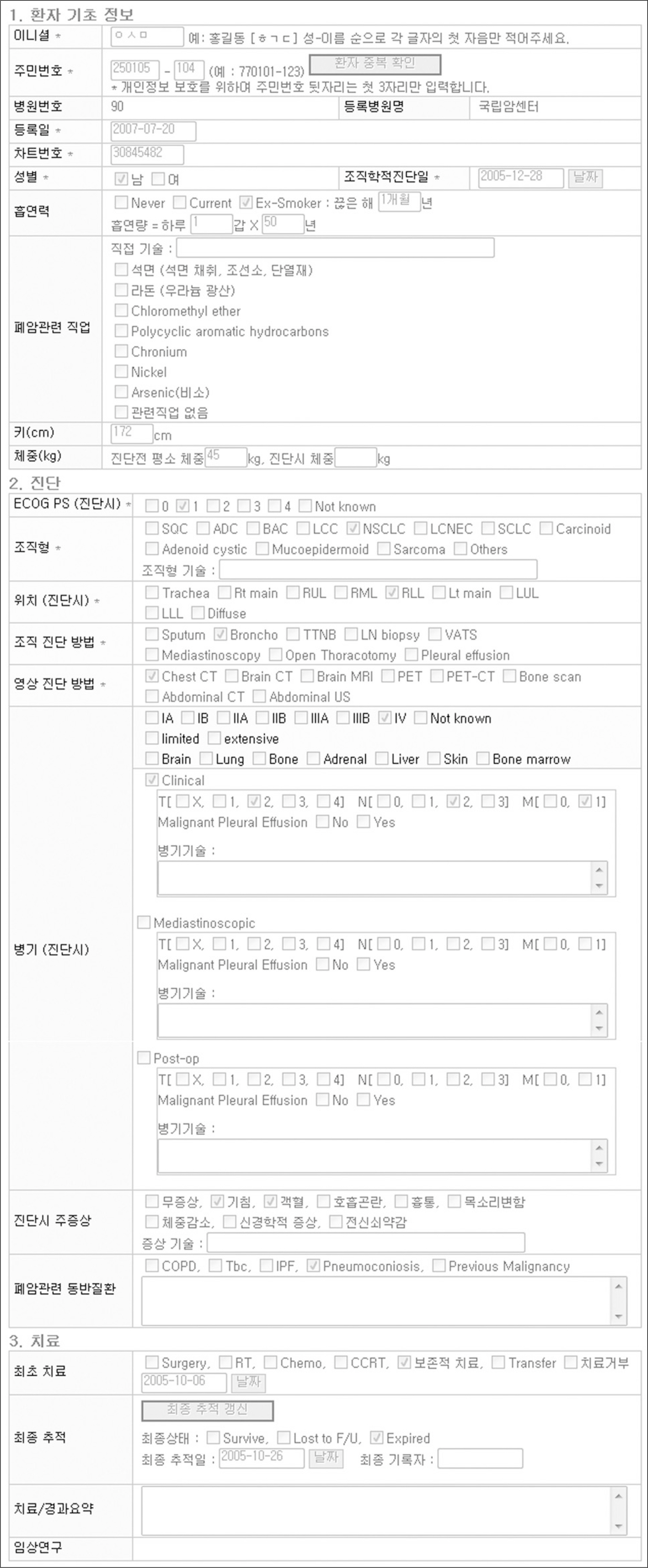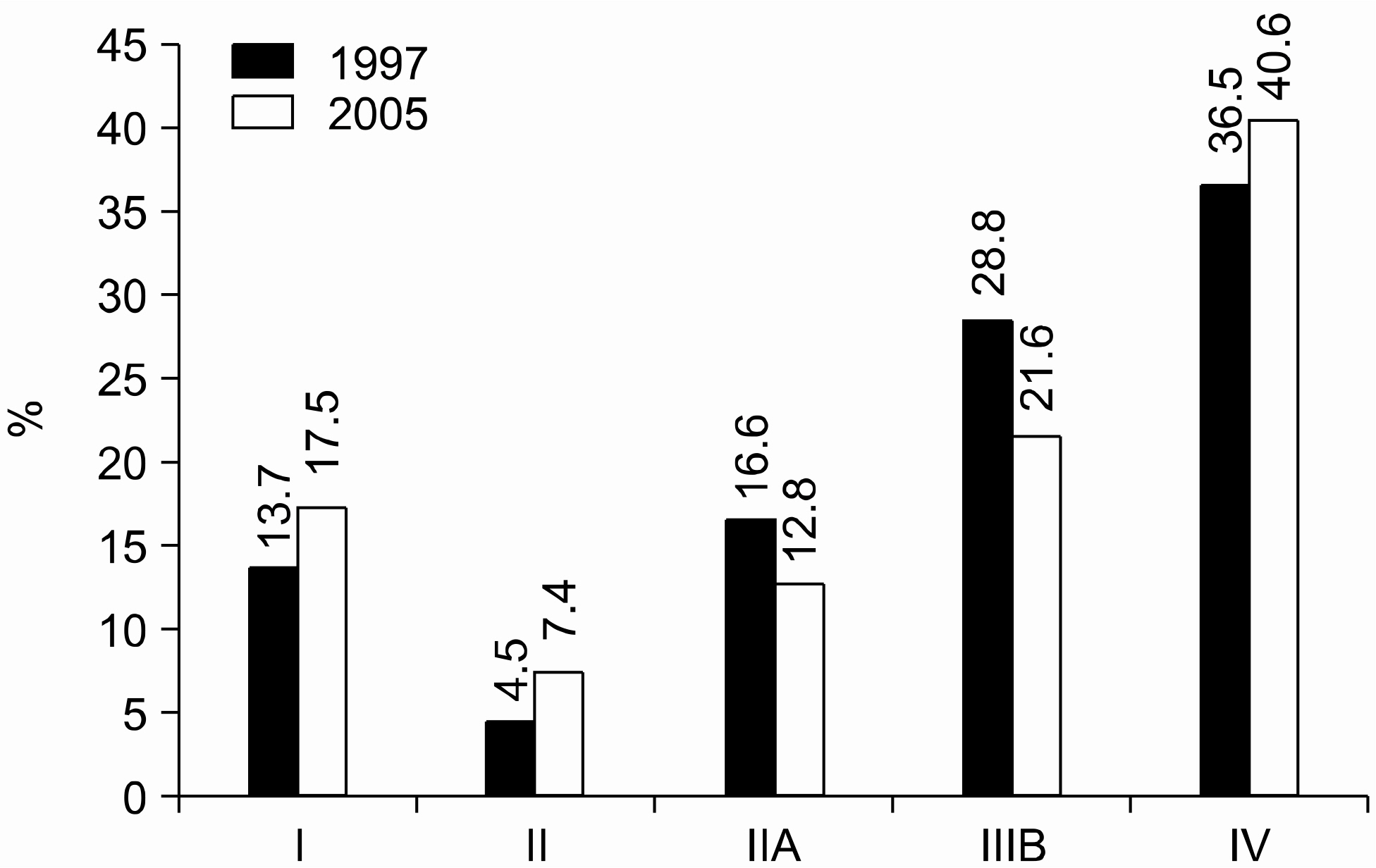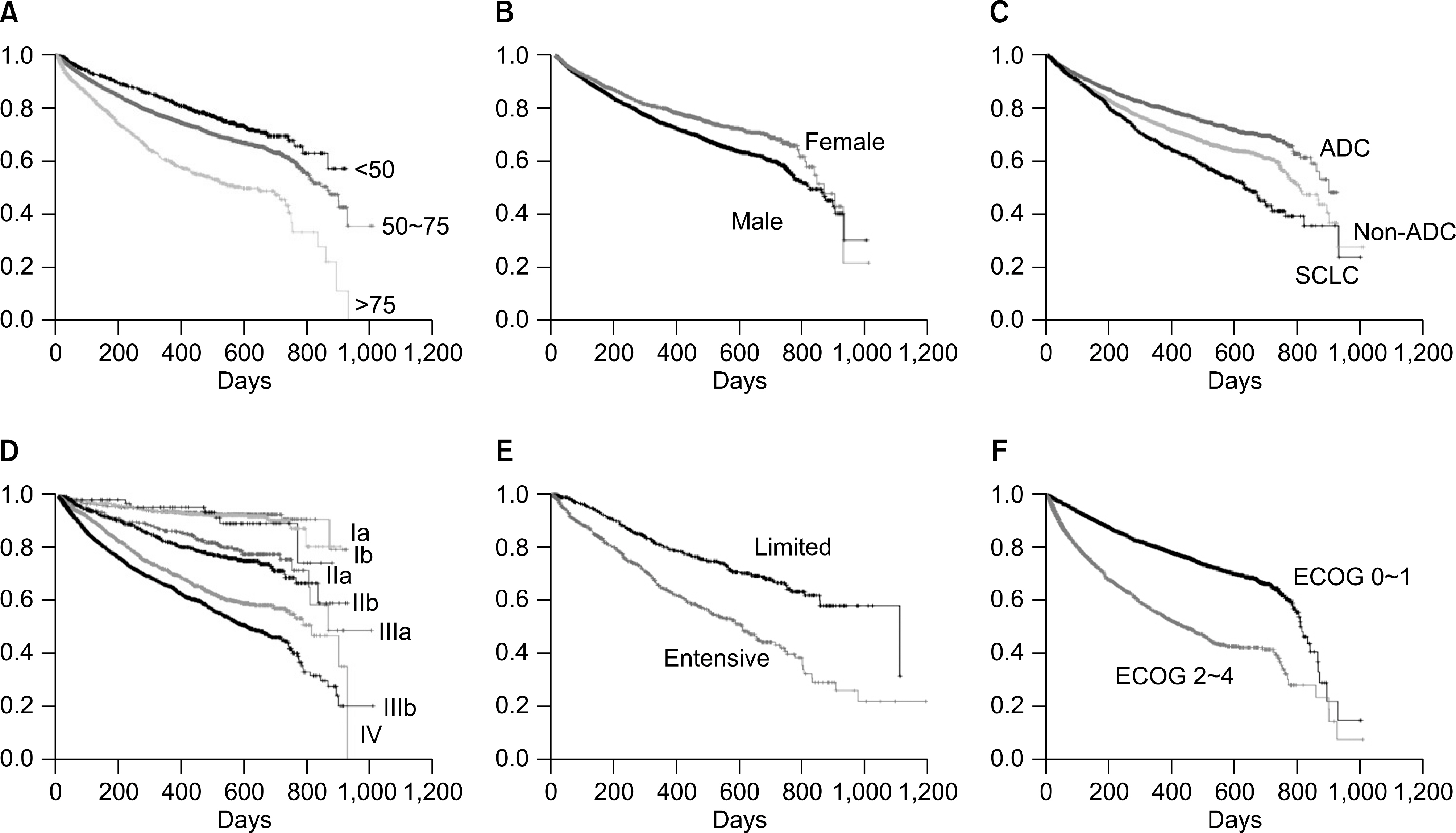National Survey of Lung Cancer in Korea, 2005
- Affiliations
-
- 1The Survey Committee of Korean Association for the Study of Lung Cancer, Korea. khin@kumc.or.kr
- 2Chonnam National University, Korea.
- 3Chungnam National University, Korea.
- 4Inha University, Korea.
- 5Inje University, Korea.
- 6Yeonsei University, Korea.
- 7Yeungnam University, Korea.
- 8Korea University, Korea.
- 9Kosin University, Korea.
- 10Wonkwang University, Korea.
- KMID: 1820247
- DOI: http://doi.org/10.6058/jlc.2007.6.2.67
Abstract
-
PURPOSE : Lung Cancer has been the leading cause of cancer deaths in South Korea since the year 2000, and its incidence continues to rise. Here we report the result of national survey of lung cancer conducted by Korean association for the study of lung cancer (KASLC).
MATERIALS AND METHODS
: A total of 8,788 lung cancer patients diagnosed in 2005 were registered using a web based case report form issued to hospitals equipped with more than 400 beds.
RESULTS
: The age distribution ranged from 11 to 105 years (64.7+/-0.7 years), 75.8% (6,664) of the patients were male and 28.9% of patients were never smokers. Subjective symptoms at the time of diagnosis included coughing (3,350 patients), dyspnea (2,105), chest pain (1,067), hemoptysis (805), weight loss (789), general weakness (498) and hoarseness (190), while 12% (1,015) of patients had no subjective symptoms. Of the carcinomas grouped into non-small cell lung carcinoma (NSCLC), adenocarcinoma including bronchoalveolar cell carcinoma (1.3%) was the most frequent (36.1%) histopathologic type, followed by squamous cell lung carcinoma (32.1%), large cell carcinoma (1.5%), unclassified non-small cell carcinoma (13.2%) and others (3.7%). In addition, 13.5% of all of the patients were afflicted with small cell lung carcinoma (SCLC). The stage at diagnosis was IA (7.3%), IB (10.2%), IIA (1.3%), IIB (6.1%), IIIA (12.8%), IIIB (21.6%), and IV (40.6%) in the NSCLC group. In SCLC group, 44.6% of the patients were in the limited stage, while 55.4% of the patients were in the extensive stage. The initial treatments included surgery (22.1%), radiation therapy (7.8%), chemo-radiation therapy (5.4%) and chemotherapy (38%), however, 26.6% of the patients were transferred or recorded to have supportive care only. Therefore we compared the outcomes of the Treatment Group (TG, 73.4%) and the Supportive Group (SG, 26.6%). The median survival time (MST) in months (m) was 28 (95% confidence interval 26.5~29.5 m). Multivariate analysis indicated that the independent prognostic factors for NSCLC were age, gender, ECOG PS score, stage, histopathologic type, and treatment or supportive care. In the SCLC group, age, PS score, stage, treatment or supportive care were significant prognostic factors. The TG group showed significantly superior survival when compared to the SG group, even in patients with stage IV disease and in patients that were >75 years old.
CONCLUSION
: Adenocarcinoma was found to be the most frequent histopathologic type, and active treatments were found to improve the survival of patients with lung cancer, even when they were in advanced stages or elderly
Keyword
MeSH Terms
Figure
Cited by 7 articles
-
MDA-7/IL-24 Expression and Its Relation with Clinicopathologic Factors in Lung Adenocarcinomas of 3 cm or Less in Diameter
Mee Sook Roh, Phil Jo Choi, Choonhee Son, Soo Keol Lee
J Lung Cancer. 2012;11(2):71-76. doi: 10.6058/jlc.2012.11.2.71.Never-Smoker Lung Cancer Is Increasing
Hyunwook Kang, Chan-Woo Park, Woojin Kim, Sang-Yun Song, Kook-Joo Na, Jae Uk Jeong, Mee Sun Yoon, Sung-Ja Ahn, Yoo-Duk Choi, Chan Choi, Daun Lee, Hyun Ju Seon, Yun-Hyeon Kim, Seong Young Kwon, Hee-Seung Bom, In-Jae Oh, Kyu-Sik Kim, Young-Chul Kim
J Lung Cancer. 2012;11(2):89-93. doi: 10.6058/jlc.2012.11.2.89.Development of a Multidisciplinary Care System for Lung Cancer Patients
Kook-Joo Na, Sung-Ja Ahn, Yun-Hyeon Kim, Hee-Seung Bom, Chan Choi, Kyu-Sik Kim, In-Jae Oh, Sang-Yun Song, Song Choi, Yoo-Duk Choi, Shin-Young Jeong, Mee-Sun Yoon, Sun-Mi Back, Kang-Eun Kong, Young-Chul Kim
J Lung Cancer. 2008;7(2):75-80. doi: 10.6058/jlc.2008.7.2.75.Clinical Features of the Lung Cancer Patients Who Were Seen in Kosin University Gospel Hospital from 1994 to 1998
Tae Won Jang, Mann Hong Jung
J Lung Cancer. 2008;7(2):81-85. doi: 10.6058/jlc.2008.7.2.81.Biomarkers for Lung Cancer
Sei Hoon Yang
J Lung Cancer. 2009;8(2):67-77. doi: 10.6058/jlc.2009.8.2.67.Female Lung Cancer: Re-Analysis of National Survey of Lung Cancer in Korea, 2005
Tae-Won Jang, Young-Chul Kim, Yong-Soo Kwon, In-Jae Oh, Kyu-Sik Kim, Sun-Young Kim, Jeong-Seon Ryu, Ho-Kee Yum, Kwan-Ho Lee, Suk-Joong Yong, Chang-Geol Lee, Sang-Yeub Lee, Sung-Yong Lee, Eun-Taik Jeong, Kwang-Ho In, Maan-Hong Jung
J Lung Cancer. 2010;9(2):57-63. doi: 10.6058/jlc.2010.9.2.57.Characteristics of Peripheral versus Central Lung Cancer Since 2000
So Young Ock, Tae Won Jang, You Jin Han, Go Eun Yeo, Eun Jung Kim, Won Hyoung Lee, Nam Kyu Kim
Kosin Med J. 2014;29(1):47-52. doi: 10.7180/kmj.2014.29.1.47.
Reference
-
References
1. Seo JH, Jeong CS. Death rate statistics of Korea, 2003: Korea National Statistical Office;. 2004.2. Korean Cancer Registry. Annual report of the Koean Cancer Registry. 2005.3. Scientific Committee of Korean Academy of Tuberculosis and Respiratory Diseases. The national survey of lung cancer in Korea. Tuberculosis and Respiratory Diseases. 1999; 46:455–465.4. Rivera MP, Stover DE. Gender and lung cancer. Clin Chest Med. 2004; 25:391–400.
Article5. Straus GM, Jemal A, McKenna MB, Straus JA, Cummings KM. The epidemic of smoking-related adenocarcinoma of the lung: The role of the tobacco industry and filtered and low-tar cigarettes. J of Thoracic Oncology;. 2007. Sep; Seoul, Korea; 2007. p. S305.6. Bach PB, Kelley MJ, Tate RC, McCrory DC. Screening for lung cancer: a review of the current literature. Chest. 2003; 123(1 Suppl):72S–82S.7. Henschke CI, Naidich DP, Yankelevitz DF, et al. Early lung cancer action project: initial findings on repeat screenings. Cancer. 2001; 92:153–159.8. The international early lung cancer action program investigators. International early lung cancer action program. [cited; Available from:. http://www.ielcap.org/.9. NCI. National Lung Screening Trial. [cited; Available from:. http://www.cancer.gov/clinicaltrials/NCI-NLST#StudyIdInfo_CDR0000257938.10. Henschke CI, Yankelevitz DF, Libby DM, Pasmantier MW, Smith JP, Miettinen OS. Survival of patients with stage I lung cancer detected on CT screening. N Engl J Med. 2006; 355:1763–1771.11. Chang A, Parikh P, Thongprasert S, et al. Gefitinib (IRESSA) in patients of Asian origin with refractory advanced nonsmall cell lung cancer: subset analysis from the ISEL study. J Thorac Oncol. 2006; 1:847–855.
Article12. Kim KS, Jeong JY, Kim YC, et al. Predictors of the response to gefitinib in refractory nonsmall cell lung cancer. Clin Cancer Res. 2005; 11:2244–2251.
Article13. Ou SH, Zell JA, Ziogas A, Anton-Culver H. Prognostic factors for survival of stage I nonsmall cell lung cancer patients: a population-based analysis of 19,702 stage I patients in the California Cancer Registry from 1989 to 2003. Cancer. 2007; 110:1532–1541.








